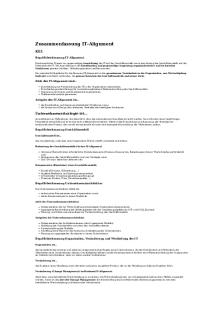9 Incentive Alignment PDF PDF

| Title | 9 Incentive Alignment PDF |
|---|---|
| Author | Olivia Williams |
| Course | Economics for Management |
| Institution | University of Exeter |
| Pages | 2 |
| File Size | 74 KB |
| File Type | |
| Total Downloads | 90 |
| Total Views | 155 |
Summary
Download 9 Incentive Alignment PDF PDF
Description
9 Incentive Alignment • Aligning incentives within an organisation. • Many conflicts of interest within organisation such as firms can be thought as a ‘principle-agent problem’. Principle Agent Relationships Definition: A principal wants an agent to act on her behalf but agents often have different goals and preferences than do principles. - Firm owner or a large firm = principle. - Firm employee = agent. Incentive Conflict • The agent has different incentives than the principal, the principal must manage the incentive conflict which comes down to two problems. • Adverse selection - The principal has to decide which agent to hire. • Moral Hazard - Once hired, the principal must find a way to motivate the agent. • Both problems are caused by asymmetric information. • Adverse selection implies that only the agent knows his type, while moral hazard means that only the agent knows how much effort he is exerting. • The cost of addressing moral hazard and adverse selection are known as agency costs when they are analysed. Agency Costs • A principal can reduce agency costs if she gathers information and so reduces information symmetry about the agent’s type (adverse selection) or about the agent’s actions (moral hazard). • We gather information to mitigate adverse selection problems so firms can run background checks on agents before they are hired and to mitigate hazard problems so firms can monitor an agent’s behaviour while working. Incentive Pay vs. Risk • Incentive pay can help align the incentives of employees (agents) with the goals of the organisation (principal). - Eg. Harder work = higher sales, creates incentives by tying employees reward to sales performance through commission. • Incentive pay imposes risk on agents. • Commissions mean a portion of an agent’s compensation is dependent on factors beyond the agent’s control - Eg. Weather. • Agents must be compensated for taking on this additional risk. • Incentive compensation represents the tradeoff of does the benefit (harder work by agent) outweigh the cost (extra compensation for bearing risk)? Controlling Incentive Conflict • In an ideal organisation, decision makers have all the information necessary to make profitable decisions and the incentive to do so. • When designing an organisation consider: - Decision Rights - Who should make the decisions? - Information - Is the decision maker provided with enough information to make a good decision? - Incentives - Does the decision maker have the incentive to do so? • Incentives are created by linking performance evaluation and reward systems rewarding good performance. Decision Rights & Information
Decentralise Decision Making • Move decisions rights down the hierarchy, closer to those with better information. • If you decentralise decision making authority, you should strengthen incentive compensation schemes. Centralise Decision Making • Move decision rights up in the hierarchy, closer to those with better incentives. - Eg. Those with ownership rights over the organisation. • If you centralise decision making, find a way to transfer information to those making decisions. Incentives Performance Evaluation • Informal: Using subjective performance evaluation - Eg. Peer review. • Formal: Using objective measures such as sales, accounting profit, stock price and relative performance metrics. Rewards • Decide how compensation is tied to performance evaluation. • Reward good performance and/or penalise bad performance. - Eg. Bonus, increased probability of promotion, faster promotion. Diagnosing & Solving Problems 1. Who is making the bad decision? 2. Did the agent have enough information to make a good decision? 3. Did the agent have the incentive to do so? (How is the employee evaluated and compensated? Alternatives for Reducing Agency Costs 1. Let someone else make the decision. 2. Change the information flow. 3. Change the incentives....
Similar Free PDFs

9 Incentive Alignment PDF
- 2 Pages

SPM BAB 9 (Incentive System)
- 10 Pages

Incentive travel
- 14 Pages

Incentive Spirometer Teaching
- 1 Pages

Chapter 2 Internal Alignment
- 26 Pages

Pdf-9 - LAB 9 ANSWERS
- 18 Pages

Pdf-9 - HW 9 SOL
- 18 Pages

IT-Alignment-Zusammenfassung
- 18 Pages

9 Budgeting PDF
- 3 Pages

9. L’Appareil digestif pdf
- 16 Pages

Opto T.9 PDF - ...
- 6 Pages

51324939 API 686 shaft alignment
- 21 Pages
Popular Institutions
- Tinajero National High School - Annex
- Politeknik Caltex Riau
- Yokohama City University
- SGT University
- University of Al-Qadisiyah
- Divine Word College of Vigan
- Techniek College Rotterdam
- Universidade de Santiago
- Universiti Teknologi MARA Cawangan Johor Kampus Pasir Gudang
- Poltekkes Kemenkes Yogyakarta
- Baguio City National High School
- Colegio san marcos
- preparatoria uno
- Centro de Bachillerato Tecnológico Industrial y de Servicios No. 107
- Dalian Maritime University
- Quang Trung Secondary School
- Colegio Tecnológico en Informática
- Corporación Regional de Educación Superior
- Grupo CEDVA
- Dar Al Uloom University
- Centro de Estudios Preuniversitarios de la Universidad Nacional de Ingeniería
- 上智大学
- Aakash International School, Nuna Majara
- San Felipe Neri Catholic School
- Kang Chiao International School - New Taipei City
- Misamis Occidental National High School
- Institución Educativa Escuela Normal Juan Ladrilleros
- Kolehiyo ng Pantukan
- Batanes State College
- Instituto Continental
- Sekolah Menengah Kejuruan Kesehatan Kaltara (Tarakan)
- Colegio de La Inmaculada Concepcion - Cebu



